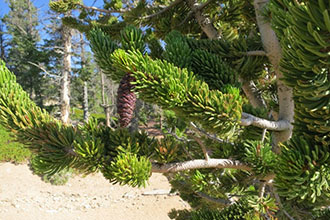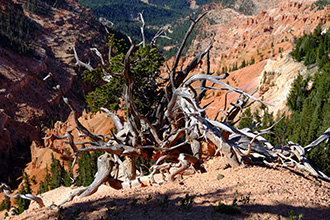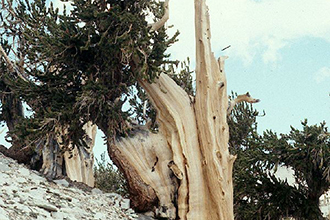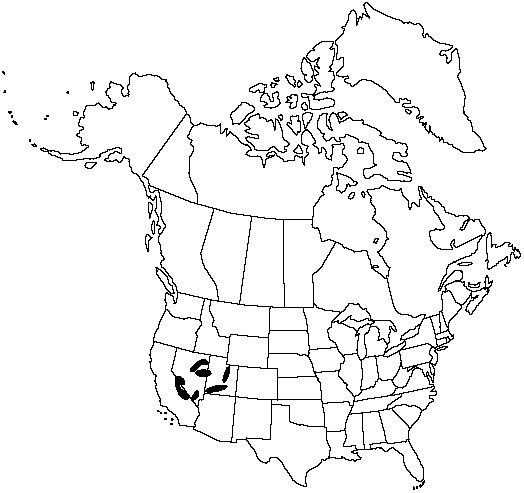Taxonomy: Kingdom - Plantae (plants). Subkingdom - Tracheobionta (vascular plants). Superdivision - Spermatophyta (seed plants). Division - Coniferophyta (conifers). Class - Pinopsida. Order - Pinales. Family - Pinaceae (pine). Genus - Pinus L. Species - Pinus longaeva D. K. Bailey
Ecology: Great Basin bristlecone pine is a long living high-elevation native conifer of highly variable growth form. At lower elevations, trees are typically upright, while at high elevations Great Basin bristlecone pine becomes twisted and contorted. Great Basin bristlecone pine may have single or multiple trunks. Unlike foxtail pine, which has very thick bark, Great Basin bristlecone pine bark is thin. Great Basin bristlecone pines on harsh sites have a high proportion of dead trunk and branchwood. Old trunks and exposed roots have thick, vertical ribbons of dead wood. Between the dead wood, thin strips of living root and stem tissue support living branches. The Great Basin bristlecone pine's root system is mostly composed of highly branched, shallow roots. A few large, branching roots provide structural support. In old age, structural roots may buttress when denudation exposes large lateral roots. Pinus longaeva can reach extremely old ages. The oldest known living organism is a 5,065 year old Great Basin bristlecone pine in the White Mountains of California. Other Pinus longaeva in Nevada, Utah, and Arizona have been found to be 1,000 to 5,000 years old. Great Basin bristlecone pine communities are very open at high elevations, and understories are sparse. Great Basin bristlecone pine is both a pioneer species and, on open harsh sites, a climax species. Great Basin bristlecone pine establishes and shows rapid, vigorous growth on open mesic sites. However, it competes poorly for water and nutrients, and is usually excluded from good sites. It is considered a topoedaphic climax species on droughty sites with nutrient-poor soils. The limestone soils that favor Great Basin bristlecone pine are too low in phosphorus to support potential competitors. On these dry, nutrient-poor sites, Great Basin bristlecone pine outcompetes associated species including limber pine.Great Basin bristlecone pine is shade intolerant and cannot establish in dense forest.
In the Utah Forest Dynamics Plot, Pinus longaeva is the 5th most common species by number of stems, but it represents a disproportionate amount of the basal area, second only to Populus tremuloides and Abies bifolia.



